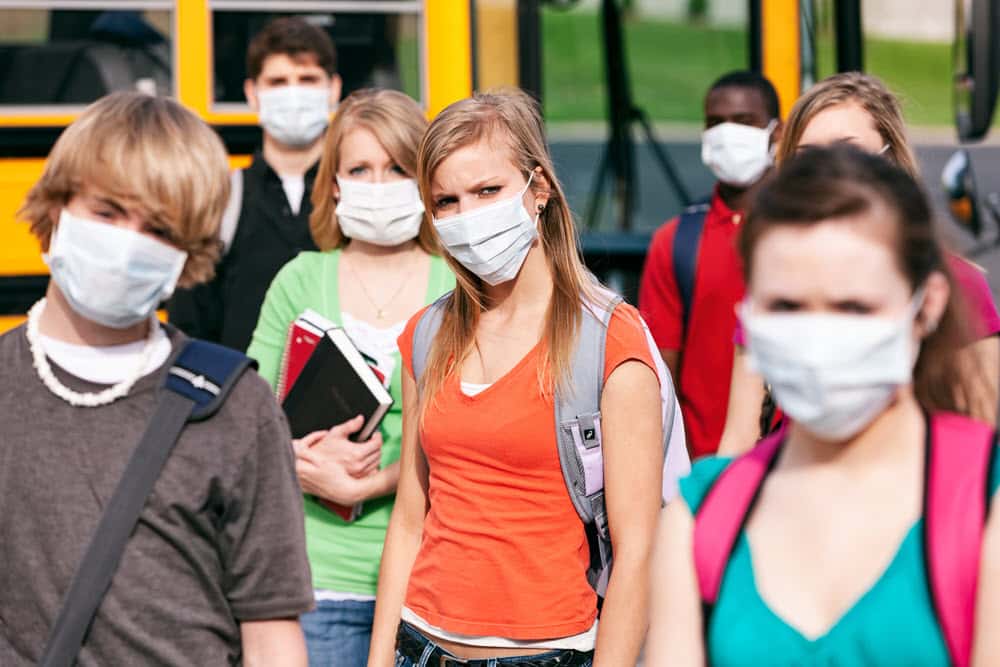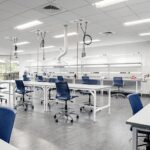After months of overseeing their children’s online instruction at home, the question on the lips of every parent with school or college-age kids is, “will it be safe for my children to go back to school?”
Meanwhile, teachers and school administrators, who were thrust into the unenviable position of suddenly having to create an online instruction curriculum out of thin air just a few months ago, are now grappling with the next challenge: preparing to welcome students back on campus and devising plans and policies to keep them safe once they return.

12 Compelling Reasons Why Students Need to Return to School
Quite understandably, there’s been a lot of uncertainty among parents, instructors, and school administrators about the various proposed plans for students to return to in-person instruction.
Nonetheless, school districts across the country are working hard to prepare their campuses to welcome back returning students.
Here are 12 reasons why advocates for reopening schools believe it’s the right thing to do:
- Schools Underpin the Economy
Economists and government officials believe we need functioning schools for the economy to recover. Many working parents are simply unable to return to their jobs if they have school-age children at home. Furthermore, the economy depends upon young school graduates entering the workforce to replace retiring baby boomers.
- Evidence that Schools Can Reopen Safely
If done correctly, reopening schools appears to be safe, based on the experience of other countries and research showing children are less likely to transmit the virus and have significantly lower morbidity rates than adult populations.

- Pediatrician Group Argues that Schools Need to Reopen for Student Well-Being
Medical experts at the American Academy of Pediatrics (AAP) recommend reopening schools, pointing out there is a greater risk of long-term harm due to developmental problems if students remain out of school.
- Schools Help Develop Socialization Skills
Students not attending school will miss out on developing important socialization skills, such as cooperation and teamwork, recognized as key factors for success in life and at work.
- Team Sports and Non-Academic Activities at Risk
School is not all about academics. Students outside of school cannot easily participate in extracurricular activities, such as team sports.
- The Need to Build Interpersonal Relationships
Students not attending school in person, especially at the collegiate level, will find it more difficult to develop personal connections and social relationships that will benefit their personal lives and future careers.
- Remote Instruction May Worsen Graduation Rates
Many at-risk students appear to be tuning out of online classes altogether, compounding the problem of low graduation rates.
- Equity and Equality
Advocates for educational equity and equality point out that remote instruction puts low-income students, students with special needs, and ESL students at a disadvantage. Consider just one example: in normal circumstances, schools serve more the 20 million lunches to economically disadvantaged students every school day.
- Risk to Project-Based Learning Approach
Many schools have adopted the Project-Based Learning (PBL) pedagogy in which students work together in small groups with the teacher acting as the facilitator — a teaching approach that is difficult to replicate with remote instruction alone.
- Schools have Critical STEM Teaching Resources
Today’s STEM instruction depends on resources that are too expensive to replicate in the home, such as school laboratories and makerspaces, which help students (and tomorrow’s workforce) acquire practical job skills through hands-on learning.

- School Funding Models Disrupted by Remote Education
Traditional school district funding models (e.g. state reimbursements) are inextricably tied to pupil attendance days. Teacher contracts are also based on traditional in-school teacher hours. Renegotiating these complex funding arrangements and labor contracts will take significant time and effort.
- Standardized Tests and Graduation rates
Many school systems around the country are obliged to show ongoing improvement in the high-stakes standardized test scores, whose outcome can determine whether an individual student can graduate, whether a teacher will be able to renew their employment contract, or whether a poor performing school will face direct intervention from state authorities.
Recommendations from the CDC and the National Council on School Facilities for Reconfiguring School Campuses to Create a Safe Learning Environment
Across the country, school administrators are busy preparing their campuses for the return of students, even if they are unsure of the exact date that they will eventually return.
What guidance is available for school administrators to turn to when making decisions about preparing their facilities?
CDC Guidelines for School Administrators
The first set of key resources come from The Centers for Disease Control (CDC), which has produced a series of Coronavirus guidelines specifically for educational institutions:
- COVID-19 Consideration for Schools
- Interim Guidance for Administrators of U.S. Childcare Programs and K-12 Schools to Plan, Prepare, and Respond to Coronavirus Disease 2019
The CDC has also published specific Environmental Cleaning and Disinfection Recommendations for schools and community centers, which reference the EPA’s list of disinfectants shown to be effective in controlling the Covid-19 virus.
Tip: Read our recent article to learn more about bulk sanitation procedures used in hospitals, schools, and offices.
Covid-19 Resources from the National Council on School Facilities
The second set of resources that school administrators should be aware of comes from the National Council on School Facilities, which is conducting ongoing working sessions on how to reopen K-12 schools as well as publishing resources, such as Excel reopening checklists and links to guidance from each state’s education and health service organizations.
How Will School Floorplans Need to Change as a Result of Coronavirus?
Establishing proper social distancing throughout the school campus is a major challenge for facility planners.
For a start, signage and markers will need to be put in place to indicate how far apart students need to stand when waiting in line on sidewalks or hallways, or when playing on playgrounds.
Preventing congestion inside school buildings is a considerable challenge, especially in older buildings, which tend to have narrower hallways and constricted intersections at doorways and stairwells. In some cases, it may be necessary to create one-way circulation to reduce bottlenecks and overcrowding.
Drinking fountains, restroom access, and lockers are other areas of concern. Drinking fountains need to be disabled (to be replaced with bottled water). Restrooms facilities will need to be upgraded to touchless water faucets, soap dispensers, and paper towel dispensers (high-velocity air dryers are out, as they can spread coronavirus). Lockers will need to be spaced further apart or, more likely, removed or cordoned off completely.
But the biggest change of all is the classroom itself.
Why?
In order to meet the new CDC guidelines, students will need to sit further apart, spaced out on a 9 ft.² grid so that each student maintains a 6-foot radius of separation from adjacent students.
Education Week created this useful graphic showing how to calculate the new amount of floor space required to adequately maintain social distancing in the classroom.
The result of this change is dramatic from a space-planning perspective because it reduces the number of students that can fit in a classroom by 50% or more. Take a typical classroom originally designed for 30 students – after spacing the seating further apart, it may only be possible to fit 12 students in the same physical space, a more than 50% reduction in capacity.

That’s why school administrators and facility planners are scrambling to find more floor space to teach students.
According to New York City Mayor Bill de Blasio, who was quoted speaking about reopening New York City schools in September to its 1.1 million students, “we’re going to convert everything that can be converted to a classroom to accommodate social distancing.”
The bottom line is that school facility managers will be looking at every opportunity to convert any available space (including outdoor seating areas) into classroom areas.
Formaspace can help. We manufacture custom furniture solutions here at our Austin, Texas factory headquarters, including mobile desks (which makes it easy to reconfigure layouts because they can be ruled in the place and locked into position).
Speak to your Formaspace Design Consultant for ideas on how we can help you convert non-traditional teaching environments, such as gymnasiums, cafeterias, or even existing laboratories and makerspace/shop areas, into new classrooms.

Schools are Looking at New Scheduling Strategies to Reduce the Risk of Viral Transmission
When schools reopen, will classes resume on a normal schedule?
Not necessarily.
School administrators are taking a hard look at so-called hybrid scheduling as a strategy to cope with the need to reduce the density of students returning to school campuses (e.g. to meet social distancing guidelines).
In fact, there are now six different approaches under consideration to transition from remote instruction to in-person instruction:
- Phased Reopening
In this approach, only certain grade levels would return to campus. Yale University intends to use this approach, inviting certain year students back to campus for in-person instruction while others class years remain at home using remote learning. - Multitrack Shifts Alternating throughout the School Week
Here, groups of students attend in-person instruction on the school campus only on alternate days (typically, two days a week) with the balance instruction occurring via remote learning. - Staggered Shifts during Each School Day
Similar to factory shiftwork, one group of students would come to school in the morning, while others are scheduled to arrive in the afternoon. This allows each student to receive some in-person instruction every day, as well as having access to a school lunch. - Long Alternating (Cyclical) Shifts
This scheduling method takes the incubation period of the virus into account. School campuses are open for a period of time (such as a week), then students return to remote learning at home for a longer period of time (two weeks, for example) in order to monitor whether any student or teacher contracts coronavirus. - Bubble Groups
In this strategy, which is recommended by the CDC, students are permanently assigned membership in a group that always attend classes together, ideally in the same physical classroom, to avoid contact with other students (thus reducing the potential for social contact on campus). - Extended School Year or Saturday Instruction
School administrators are also weighing the idea of moving to a year-round school calendar (eliminating the long summer break) or even adding Saturday instruction as a way to increase classroom availability.
What will the Education System look like when we’re on the Other Side of this Pandemic?
The sudden shift to online education has been dramatic.
It’s probably fair to say that the field of education has changed more in the last few months than it has in the last decade or two.
Looking ahead, we all hope and pray that new clinical therapies (and the availability of and effective Covid-19 vaccine) will allow us to return to what we may call a “normal” pre-pandemic life.
But when that day comes, will the changes that have taken place in our education system during 2020 simply fade away – or is this the start of something new and permanent?
Indeed, it’s entirely possible some forms of hybrid instruction may become established as a permanent fixture in our education system.
For example, hybrid instruction could certainly help solve some of the chronic staffing issues facing school administrators, such as recruiting highly sought after STEM instructors, who could work from remote locations outside the school district (serving multiple schools or even multiple districts) rather than being tied to one particular school campus.
Hybrid instruction could also encourage the participation of Professional Learning Communities (PLCs), e.g. groups of professional and nonprofessional educators that are dedicated to creating more educational resources and improving teaching.
Hybrid instruction will also allow education researchers to collect more data on the relative value of synchronous versus asynchronous learning, which has been a topic of great debate among educators. (In classroom teaching and live video, classes are synchronous using pre-recorded videos or software-based learning programs.)
Speaking of pedagogy, the ongoing trend toward Project-Based Learning (PBL) may evolve further thanks to hybrid instruction scheduling. One component of PBL, at-home learning, is well-suited to remote instruction as it already takes place in the home. However, current PBL teaching approaches rely heavily on students returning to school to work face-to-face with their fellow group project members and to present their projects to the teacher, who can provide face-to-face student feedback and perform formative or summative assessments of their progress. New strategies that allow some or all of these activities to take place through remote learning (via computer video chat/groupware, for example) could be a boon to expanding the role of PBL in the classroom.
Education tech companies, always eager to expand their footprint in the classroom, may take this as an opportunity to introduce more advanced AI-based teaching models that focus on streamlining certain tasks, such as grading basic exams (allowing teachers more time to focus on other tasks, such as critiquing student writing). And, thanks to in approved language processing, AI-based educational software systems are poised to offer significantly more advanced tools to help evaluate and teach non-English language-based students, which could help augment the limited amount of foreign language instruction resources throughout the school system.
Formaspace is Your Education Partner for Safer School Facilities
When it comes to creating safer school environments, Formaspace can help.
As one of the leading US manufacturing companies dedicated to building furniture for laboratories, schools, offices, and government facilities, we can help.
We are operating at full capacity here at our Austin, Texas factory headquarters, building new furniture solutions to help facility managers comply with the new Covid-19 safety regulations.
Talk to your Formaspace Design Consultant today to find out how we can assist you.
We are ready to help, by offering fast delivery on custom, American-made products that you need to prepare your schools to reopen this fall.
Attention TIPS Members: If your school district, government agency, or non-profit organization is a member of The Interlocal Purchasing System (TIPS) Purchasing Cooperative, you can now purchase Formaspace furniture products and accessories using competitively procured purchasing contracts available exclusively to TIPS members — thus avoiding the additional expense and delay inherent in the traditional bidding process. Visit the Formaspace TIPS page for more information. (Be sure to note down the Formaspace TIPS contract number: # 2003001.)












